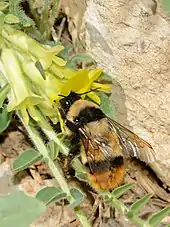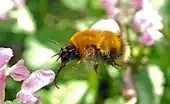The list presented here is a checklist of global bumblebee[1] species (Tribe Bombini) based on the Bombus phylogeny presented by Cameron et al (2007)[2] and grouped by subgenus following the revision of Williams et al (2008).[3] The bumblebee fossil record extends back to the Late Eocene in North America and England with the most diversity of fossils found during the Miocene. The fossil species were discussed and revised by Dehon et al (2019).[4]
Genus Bombus
Subgenus Alpigenobombus
Subgenus Alpinobombus
- Bombus alpinus
- Bombus balteatus – golden-belted bumble bee
- Bombus hyperboreus
- Bombus kirbiellus
- Bombus kluanensis
- Bombus natvigi
- Bombus neoboreus
- Bombus polaris
- Bombus pyrrhopygus
Subgenus Bombias
- Bombus auricomus – black-and-gold bumble bee
- Bombus confusus
- Bombus nevadensis – Nevada bumble bee
Subgenus Bombus (sensu stricto)

Bombus cryptarum

Bombus lucorum
- Bombus affinis – rusty-patched bumble bee
- Bombus cryptarum – cryptic bumble bee
- Bombus franklini – Franklin's Bumblebee (extremely rare or possibly extinct)
- Bombus hypocrita
- Bombus ignitus
- Bombus jacobsoni
- Bombus lantschouensis
- Bombus longipennis
- Bombus lucorum – white-tailed bumblebee
- Bombus magnus – northern white-tailed bumblebee
- Bombus minshanicus
- Bombus occidentalis[5] – Western Yellow-banded Bumble Bee
- Bombus patagiatus
- Bombus sporadicus
- Bombus terrestris – buff-tailed bumblebee or large earth bumblebee
- Bombus terricola[5] – yellow-banded bumble bee
- Bombus tunicatus
Subgenus Cullumanobombus
- Bombus baeri
- Bombus brachycephalus
- Bombus coccineus
- Bombus crotchii – Crotch's bumble bee
- Bombus cullumanus – Cullum's humble-bee or Cullum's bumblebee
- Bombus ecuadorius
- Bombus fraternus – southern plains bumble bee
- Bombus funebris
- Bombus griseocollis – brown-belted bumble bee
- Bombus handlirschi
- Bombus haueri
- Bombus hortulanus
- Bombus macgregori
- Bombus melaleucus
- Bombus morrisoni
- †Bombus pristinus - Middle- Late Miocene, Kumi Formation, Euboea, Greece[4]
- †Bombus randeckensis[4]
- Bombus robustus
- Bombus rohweri
- Bombus rubicundus
- Bombus rufocinctus – red-belted bumble bee
- Bombus semenoviellus
- †Bombus trophonius[6]
- Bombus tucumanus
- Bombus unicus
- Bombus vogti
Subgenus Kallobombus

Bombus soroeensis subsp. proteus
- Bombus soroeensis – broken-belted bumblebee
Subgenus Megabombus
- Bombus argillaceus
- Bombus bicoloratus
- Bombus consobrinus
- Bombus czerskii
- Bombus diversus
- Bombus gerstaeckeri
- Bombus hortorum – (small) garden bumblebee
- Bombus irisanensis
- Bombus koreanus
- Bombus longipes
- Bombus melanopoda (extremely rare or possibly extinct)
- Bombus portchinsky
- Bombus religiosus
- Bombus ruderatus – large garden bumblebee
- Bombus saltuarius
- Bombus securus
- Bombus senex
- Bombus supremus
- Bombus sushkini
- Bombus tichenkoi
- Bombus trifasciatus
- Bombus ussurensis
Subgenus Melanobombus

†Bombus cerdanyensis
holotype
holotype
- Bombus alagesianus[7]
- †Bombus cerdanyensis - Late Miocene, Bellver de Cerdanya, Spain[8][4]
- Bombus erzurumensis[9]
- Bombus eurythorax[7]
- Bombus eximius
- Bombus festivus
- Bombus formosellus
- Bombus friseanus
- Bombus incertoides[7]
- Bombus incertus
- Bombus keriensis
- Bombus ladakhensis
- Bombus lapidarius – red-tailed bumblebee
- Bombus miniatus
- Bombus prshewalskyi[7]
- Bombus pyrosoma
- Bombus qilianensis[7]
- Bombus richardsiellus
- Bombus rufipes
- Bombus rufofasciatus
- Bombus semenovianus
- Bombus sichelii
- Bombus simillimus
- Bombus tanguticus
- Bombus tibeticus[7]
Subgenus Mendacibombus
_beskonakensis.jpg.webp)
†Bombus beskonakensis fossil
- Bombus avinoviellus
- †Bombus beskonakensis (Miocene, Bes Konak paleolake, Turkey)
- Bombus convexus
- Bombus handlirschianus
- Bombus himalayanus
- Bombus makarjini
- Bombus margreiteri
- Bombus marussinus
- Bombus mendax
- Bombus superbus
- Bombus turkestanicus
- Bombus waltoni
Subgenus Orientalibombus
- Bombus braccatus
- Bombus funerarius
- Bombus haemorrhoidalis
Subgenus †Paraelectrobombus
_patriciae.jpg.webp)
Bombus patriciae holotype
- †Bombus patriciae - Late Oligocene/Early Miocene, BesKonak paleolake, Ankara, Turkey[4]
Subgenus Psithyrus

Bombus barbutellus

Bombus campestris

Bombus rupestris
- Bombus ashtoni – Ashton cuckoo bumble bee
- Bombus barbutellus – Barbut's cuckoo-bee
- Bombus bellardii
- Bombus bohemicus – Gypsy's cuckoo bumble bee
- Bombus branickii
- Bombus campestris
- Bombus chinensis
- Bombus citrinus – lemon cuckoo bumble bee
- Bombus coreanus
- Bombus cornutus
- Bombus expolitus
- Bombus ferganicus
- Bombus fernaldae – Fernald's cuckoo bumble bee
- Bombus flavidus
- Bombus insularis – indiscriminate cuckoo bumble bee
- Bombus maxillosus
- Bombus monozonus
- Bombus morawitzianus
- Bombus norvegicus
- Bombus novus
- Bombus perezi
- Bombus quadricolor
- Bombus rupestris
- Bombus skorikovi
- Bombus suckleyi – Suckley's cuckoo bumble bee
- Bombus sylvestris – forest cuckoo bumble bee
- Bombus tibetanus
- Bombus turneri
- Bombus variabilis – variable cuckoo bumble bee
- Bombus vestalis – vestal cuckoo bumble bee
Subgenus Pyrobombus
_-_Knautia_arvensis_-_Keila.jpg.webp)
Bombus pratorum (male)
_-_Succisa_pratensis_-_Keila.jpg.webp)
Bombus jonellus
- Bombus abnormis
- Bombus ardens
- Bombus avanus
- Bombus beaticola
- Bombus bifarius – two-form bumble bee
- Bombus bimaculatus – two-spotted bumble bee
- Bombus biroi
- Bombus brodmannicus
- Bombus caliginosus – obscure bumble bee
- Bombus centralis[10] – Great Basin bumble bee
- Bombus cingulatus – small tree bumble bee
- Bombus cockerelli – Cockerell's bumble bee
- Bombus ephippiatus
- Bombus flavescens
- Bombus flavifrons[10] – yellow-fronted bumble bee
- Bombus frigidus – frigid bumble bee
- Bombus haematurus
- Bombus huntii – Hunt's bumble bee
- Bombus hypnorum – tree bumble bee
- Bombus impatiens – common eastern bumble bee
- Bombus infirmus
- Bombus infrequens
- Bombus johanseni
- Bombus jonellus – small heath bumble bee
- Bombus kotzschi
- Bombus lapponicus
- Bombus lemniscatus
- Bombus lepidus
- Bombus luteipes
- Bombus melanopygus[11] – black-tailed bumble bee
- Bombus mirus
- Bombus mixtus – fuzzy-horned bumble bee
- Bombus modestus
- Bombus monticola – bilberry bumble bee
- Bombus oceanicus
- Bombus parthenius
- Bombus perplexus – perplexing bumble bee, confusing bumble bee[12]
- Bombus picipes
- Bombus pratorum – early bumble bee
- Bombus pressus
- Bombus pyrenaeus
- Bombus rotundiceps
- Bombus sandersoni – Sanderson bumble bee[12]
- Bombus sitkensis – Sitka bumble bee
- Bombus sonani
- Bombus subtypicus
- Bombus sylvicola – forest bumble bee
- Bombus ternarius – tricolored bumble bee, orange-belted bumble bee
- Bombus vagans – half-black bumble bee
- Bombus vancouverensis
- Bombus vandykei – Van Dyke's bumble bee
- Bombus vosnesenskii – yellow-faced bumble bee
- Bombus wilmattae
Subgenus Sibiricobombus

Bombus niveatus
- Bombus asiaticus
- Bombus morawitzi
- Bombus niveatus
- Bombus oberti
- Bombus obtusus
- Bombus sibiricus
- Bombus sulfureus
Subgenus Subterraneobombus
_-_Medicago_x_varia_-_Keila.jpg.webp)
Bombus pascuorum
- Bombus amurensis
- Bombus appositus – mountain bumble bee
- Bombus borealis – northern amber bumble bee
- Bombus difficillimus
- Bombus distinguendus
- Bombus fedtschenkoi
- Bombus fragrans
- Bombus melanurus
- Bombus mongolensis
- Bombus personatus
- Bombus subterraneus – short-haired bumble bee
Subgenus Thoracobombus

Bombus schrencki

Bombus sylvarum

Bombus veteranus
- Bombus anachoreta
- Bombus armeniacus – Armenian bumble bee
- Bombus atripes
- Bombus bahiensis
- Bombus bellicosus
- Bombus brasiliensis
- Bombus brevivillus
- Bombus californicus
- Bombus dahlbomii
- Bombus deuteronymus
- Bombus digressus
- Bombus diligens
- Bombus excellens
- Bombus exil
- Bombus fervidus – yellow bumble bee, golden northern bumble bee
- Bombus filchnerae
- Bombus hedini
- Bombus honshuensis
- Bombus humilis – brown-banded carder bee
- Bombus imitator
- Bombus impetuosus
- Bombus inexspectatus
- Bombus laesus
- Bombus medius
- Bombus mesomelas
- Bombus mexicanus
- Bombus mlokosievitzii
- Bombus morio
- Bombus mucidus
- Bombus muscorum – large carder bee or moss carder bee
- Bombus opifex
- Bombus opulentus
- Bombus pascuorum – common carder bee
- Bombus pauloensis[13]
- Bombus pensylvanicus – American bumble bee
- Bombus persicus
- Bombus pomorum – apple humble-bee
- Bombus pseudobaicalensis
- Bombus pullatus
- Bombus remotus
- Bombus rubriventris (probably extinct)
- Bombus ruderarius – red-shanked carder bee or red-shanked bumble bee
- Bombus schrencki
- Bombus sonorus – Sonoran bumble bee
- Bombus steindachneri
- Bombus sylvarum – shrill carder bee
- Bombus transversalis
- Bombus tricornis
- Bombus trinominatus
- Bombus velox
- Bombus weisi
- Bombus veteranus
- Bombus zonatus

Bombus vetustus
holotype male
holotype male

Calyptapis florissantensis
paratype female
paratype female

Oligobombus cuspidatus
holotype forewing
holotype forewing
Subgenus incertae sedis
- †“Bombus” anacolus - Middle Miocene Shanwang Formation, Shandong Province, China[4]
- †Bombus? crassipes - Late Miocene Krottensee deposits, Czech Republic[4]
- †“Bombus” dilectus - Middle Miocene Shanwang Formation, Shandong Province, China[4]
- †“Bombus” luianus - Middle Miocene Shanwang Formation, Shandong Province, China[4]
- †Bombus proavus - Middle Miocene, Latah Formation, Washington, USA[4]
- †Bombus vetustus - Late Miocene, Botchi Formation, Botchi River, Khabarovsk Krai, Russia[4]
Genus †Calyptapis
- †Calyptapis florissantensis - Late Eocene, Florissant Formation, Colorado
Genus †Oligobombus
- †Oligobombus cuspidatus - Late Eocene, Bembridge Marls, Isle of Wight, UK
References
- ↑ Williams, P. H. (1998). "An annotated checklist of bumble bees with an analysis of patterns of description (Hymenoptera: Apidae, Bombini)". Bulletin of the Natural History Museum, Entomology Series. 67: 79–152.
- ↑ Cameron, S. A.; Hines, H. M.; Williams, P. H. (2007). "A comprehensive phylogeny of the bumble bees (Bombus)". Biological Journal of the Linnean Society. 91: 161–188. doi:10.1111/j.1095-8312.2007.00784.x.
- ↑ Williams, P. H.; Cameron, S. A.; Hines, H. M.; Cederberg, B.; Rasmont, P. (2008). "A simplified subgeneric classification of the bumblebees (genus Bombus)" (PDF). Apidologie. 39: 1–29. doi:10.1051/apido:2007052. S2CID 3489618.
- 1 2 3 4 5 6 7 8 9 10 11 Dehon, M.; Engel, M.; Gérard, M.; Aytekin, A.; Ghisbain, G.; Williams, P.; Rasmont, P.; Michez, D. (2019). "Morphometric analysis of fossil bumble bees (Hymenoptera, Apidae, Bombini) reveals their taxonomic affinities". ZooKeys (891): 71–118. doi:10.3897/zookeys.891.32056 (inactive 1 August 2023).
{{cite journal}}: CS1 maint: DOI inactive as of August 2023 (link) - 1 2 Bombus occidentalis and Bombus terricola are sometimes considered the same species.
- ↑ Prokop, J.; Dehon, M.; Michez, D.; Engel, M. S. (2017). "An Early Miocene bumble bee from northern Bohemia (Hymenoptera, Apidae)". ZooKeys (710): 43–63. Bibcode:2017ZooK..710...43P. doi:10.3897/zookeys.710.14714. PMC 5674177. PMID 29118643.
- 1 2 3 4 5 6 Williams, P.; Altanchimeg, D.; Byvaltsev, A.; De Jonghe, R.; Jaffar, S.; Japoshvili, G.; Kahono, S.; Liang, H.; Mei, M.; Monfared, A.; Nidup, T.; Raina, R.; Ren, Z.; Thanoosing, C.; Zhao, Y.; Orr, M. (2020). "Widespread polytypic species or complexes of local species? Revising bumblebees of the subgenus Melanobombus world-wide (Hymenoptera, Apidae, Bombus)". European Journal of Taxonomy (719): 1–120. doi:10.5852/ejt.2020.719.1107. S2CID 224964830.
- ↑ Dehon, M.; Michez, D.; Nel, A.; Engel, M. S.; De Meulemeester, T. (2014). "Wing Shape of Four New Bee Fossils (Hymenoptera: Anthophila) Provides Insights to Bee Evolution". PLOS ONE. 9 (10): 1–16. Bibcode:2014PLoSO...9j8865D. doi:10.1371/journal.pone.0108865. PMC 4212905. PMID 25354170.
- ↑ Pierre Rasmont; A. Murat Aytekin; Osman Kaftanoglu & Didier Flagothier. "Bombus (Melanobombus) erzurumensis (Özbek, 1990)". Université de Mons.
- 1 2 Bombus centralis and Bombus flavifrons are sometimes considered the same species.
- ↑ Bombus melanopygus has two color forms, one of which was historically treated as a species: Bombus edwardsii.
- 1 2 Miller, Nathan G. (2010). The Bumble Bees of Algonquin Park: A Field Guide. Toronto: Toronto Entomologists' Association. pp.22.
- ↑ Cameron, S. A.; Williams, P. H. (24 July 2002). "Phylogeny of bumble bees in the New World subgenus Fervidobombus (Hymenoptera: Apidae): congruence of molecular and morphological data" (PDF). Molecular Phylogenetics and Evolution. 28 (3): 552–563. doi:10.1016/s1055-7903(03)00056-3. PMID 12927138. Retrieved 5 November 2015.
This article is issued from Wikipedia. The text is licensed under Creative Commons - Attribution - Sharealike. Additional terms may apply for the media files.
_som_bit_h%C3%B2l_i_tyrihjelm.jpg.webp)


